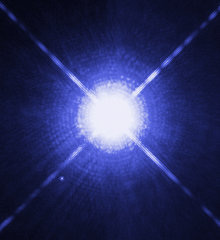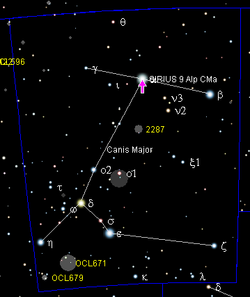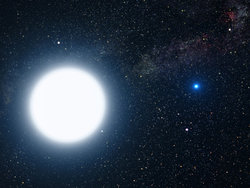Sirius
2007 Schools Wikipedia Selection. Related subjects: Space (Astronomy)
| Observation data Epoch J2000 |
|
|---|---|
| Constellation | Canis Major |
| Right ascension | 06h 45m 08.9173s |
| Declination | −16° 42' 58.017" |
| Apparent magnitude (V) | −1.47 (A) / 8.44 (B) |
| Characteristics | |
| Spectral type | A1V (A) / DA2 (B) |
| B-V colour index | 0.01 (A) / −0.03 (B) |
| U-B colour index | −0.08 (A) / −1.04 (B) |
| Variable type | Eclipsing binary |
| Astrometry | |
| Radial velocity (Rv) | −7.6 km/s |
| Proper motion (μ) | RA: −546.01 mas/ yr Dec.: −1223.08 mas/ yr |
| Parallax (π) | 379.21 ± 1.58 mas |
| Distance | 8.6 ± 0.04 ly (2.64 ± 0.01 pc) |
| Absolute magnitude (MV) | 1.47 (A) / 11.35 (B) |
| Visual binary orbit | |
| Companion | α CMa B |
| Period (P) | 50.09 years |
| Semimajor axis (a) | 7.56" |
| Eccentricity (e) | 0.5923 |
| Inclination (i) | 136.5° |
| Node (Ω) | 44.6° |
| Periastron epoch (T) | 1894.13 |
| Details | |
| Mass | 2.14 (A) / 0.98 (B) M☉ |
| Radius | 1.68 (A) / 0.008 (B) R☉ |
| Luminosity | 26.1 (A) / 0.0024 (B) L☉ |
| Temperature | 9,900 (A) / 25,200 (B) K |
| Metallicity | 190% Sun (A) |
| Rotation | |
| Age | 2-3 × 108 years |
| Other designations | |
|
α Canis Majoris, 9 CMa, HD 48915, HR 2491, BD -16°1591, Gl 119-052, GCTP 1577.00 A/B, GJ 244 A/B, LHS 219, ADS 5423, LTT 2638, HIP 32349.
|
|
| Database references | |
| SIMBAD | data |
Sirius (α CMa / α Canis Majoris / Alpha Canis Majoris) is the brightest star in the night-time sky, with a visual apparent magnitude of −1.47. This binary star system consists of a blue-white main sequence dwarf star and a faint white dwarf companion. It is located in the constellation Canis Major.
Sirius can be seen from almost every inhabited region of the Earth's surface ( those living north of 73.284 degrees cannot see it) and, in the Northern Hemisphere, is known as a vertex of the Winter Triangle. The best time of year to view it is around January 1, when it reaches the meridian at midnight.
Under the right conditions, Sirius can be observed in daylight with the naked eye. Ideally the sky must be very clear, with the observer at a high altitude, the star passing overhead, and the sun low down on the horizon.
Etymology
The name of this star comes from the Latin Sīrius, from Greek Σείριος (Seirios, "glowing" or "scorcher"). As the major star of the "Big Dog" constellation, it is often called the "Dog Star".
The Latin name for this star is Canicula ("little dog") and in Arabic: الشعرى aš-ši‘rā in Islamic astronomy, from which the alternate name Al Shira derives.
In Sanskrit, it is known as Mrgavyadha ("deer hunter") or Lubdhaka ("hunter"). As Mrgavyadha, the star represents Shiva.
In Chinese the star is known as 天狼星 (Tiānláng xīng literally, “heavenly wolf star”). The Japanese pronunciation is Tenrōsei and the Korean pronunciation 천랑성 Cheonlangseong, while Japanese vernacular name of the star is 青星 (Aoboshi).
History
Historically, many cultures have attached special significance to Sirius. Sirius was worshipped as Sothis in the valley of the Nile long before Rome was founded. The Middle Kingdom of Egyptians based their calendar on the heliacal rising of Sirius, which occurred just before the annual flooding of the Nile and the Summer solstice. In Greek mythology, Orion's dog became Sirius. The Greeks also associated Sirius with the heat of summer: they called it Σείριος Seirios, often translated "the scorcher."
In the astrology of the Middle Ages, Sirius was a Behenian fixed star, associated with beryl and juniper. Its kabbalistic symbol ![]() was listed by Heinrich Cornelius Agrippa.
was listed by Heinrich Cornelius Agrippa.
Based on changes in its proper motion, in 1844 Friedrich Wilhelm Bessel deduced that Sirius had a hidden companion. Nearly two decades later in 1862 Alvan Graham Clark discovered the faint companion, which is called Sirius B, or affectionately "the Pup". The visible star is now sometimes known as Sirius A.
In 1909 Ejnar Hertzsprung suggested that Sirius was a member of the Ursa Major Moving Group, based on the systems movements across the sky. However, more recent research by Jeremy King et al. at Clemson University in 2003 questions whether that is true, since the two components of Sirius appear to be too young. Sirius is roughly half the age of the other members of the stream, so their common motion is most likely a coincidence.
Astronomers at the Mount Wilson Observatory determined in 1915 that Sirius B was a white dwarf, the first to be discovered. The diameter of Sirius A was first measured by Robert Hanbury Brown and Richard Q. Twiss in 1959 at Jodrell Bank using their stellar intensity interferometer. In 2005, using the Hubble Space Telescope, astronomers determined that Sirius B has nearly the diameter of the Earth, 12,000 kilometers (7,500 miles), with a mass that is 98% of the Sun.
System
At a distance of 2.6 pc or 8.6 light years, Sirius is one of the nearest stars to Earth. Its closest large neighbour star except Sirius B is Procyon, 1.61 pc or 5.24 ly away.
Sirius is a main sequence star of spectral type A0 or A1 and has a mass about 2.1 times that of the Sun. It has a companion star that has already evolved off the main sequence into a white dwarf, and hence was once the more massive of the two. These two stars orbit each other with a separation of about 20 AU (roughly the distance between the Sun and Uranus) and a period of close to 50 years. The orbit of Sirius B can take the star in front of Sirius A, briefly lowering the total luminosity. For this reason the system is considered an eclipsing binary variable star.
A typical white dwarf has a mass equal to 0.5–0.6 solar masses. With a mass nearly equal to the Sun's, Sirius B is one of the more massive white dwarfs known. Yet that same mass is packed into a volume roughly equal to the Earth. White dwarfs form only after the star has evolved from the main sequence and then pass through a red giant stage. This occurred when Sirius B was less than half its current age, approximately 120 million years ago. The original star had an an estimated 5 solar masses and was probably a spectral type B7 V star when it still was on the main sequence.
While it passed through the red giant stage, Sirius B may have enriched the metallicity of its companion. For this reason Sirius A now has a higher than normal abundance of elements heavier than helium, such as iron. The Sirius star system also emits a higher than expected level of infrared radiation, as measured by IRAS. This may be an indication of dust in the system, and is considered somewhat unusual for a binary star.
The current primary, Sirius A, is expected to have completely exhausted the store of hydrogen at its core within a billion (109) years. At that point it will pass through its own red giant stage, then settle down to become a white dwarf.
Mysteries

There remain a few unsolved mysteries regarding Sirius:
Possible Third Member in System
Since 1894, some apparent orbital irregularities in Sirius B have been observed, suggesting a third very small companion star, but this has never been definitely confirmed.
Sirius' Colour
Curiously, some ancient observations of Sirius describe it as a red star. To the Romans this meant an angry god, and they are known to have sacrificed red dogs to this star. Today, Sirius A is bluish white.
The possibility that stellar evolution of either Sirius A or Sirius B could be responsible for this discrepancy is rejected by astronomers on the grounds that the timescale of thousands of years is too short and that there is no sign of the nebulosity in the system that would be expected had such a change taken place. Alternative explanations are either that the description as red is a poetic metaphor for ill fortune, or that the dramatic scintillations of the star when it was observed rising left the viewer with the impression that it was red. To the naked eye, it often appears to be flashing with red/white/blue hues when near the horizon.
The Dogon
The Dogon people are a tribal people living in Africa who are said to have known that Sirius had a companion star before its discovery in the 1840's. Of course, it is impossible to see Sirius's companion except with very powerful telescopes and at the right time of Sirius B's orbit, which lasts several years. They also supposedly knew that Saturn had rings and that Jupiter had 4 moons (Although as of 2003, Jupiter had 63 satellites, only Ganymede, Io, Europa, and Callisto can be seen with simple telescopes - all the others are only a few hundred miles wide at the most).
This apparent knowledge, which it seems impossible for them to have acquired without outside assistance, is a source of speculation for UFO enthusiasts and was the subject of the book The Sirius Mystery by Robert Temple, who linked this to the legends of the Dogon as well with the legends and traditions of the ancient Egyptians and Sumerians, conjecturing that aliens from Sirius had visited Earth and influenced early civilization.
This work has been challenged by astronomer Carl Sagan, among others, as based on selective evidence. Skeptics believe there may have been cultural contamination on the part of visiting astronomers who went to the region to observe a transit of Venus.
- see also The Dogon Controversy
Sirius in popular culture
Being the brightest star in the night sky, Sirius is often mentioned in science fiction and other popular culture as well.

